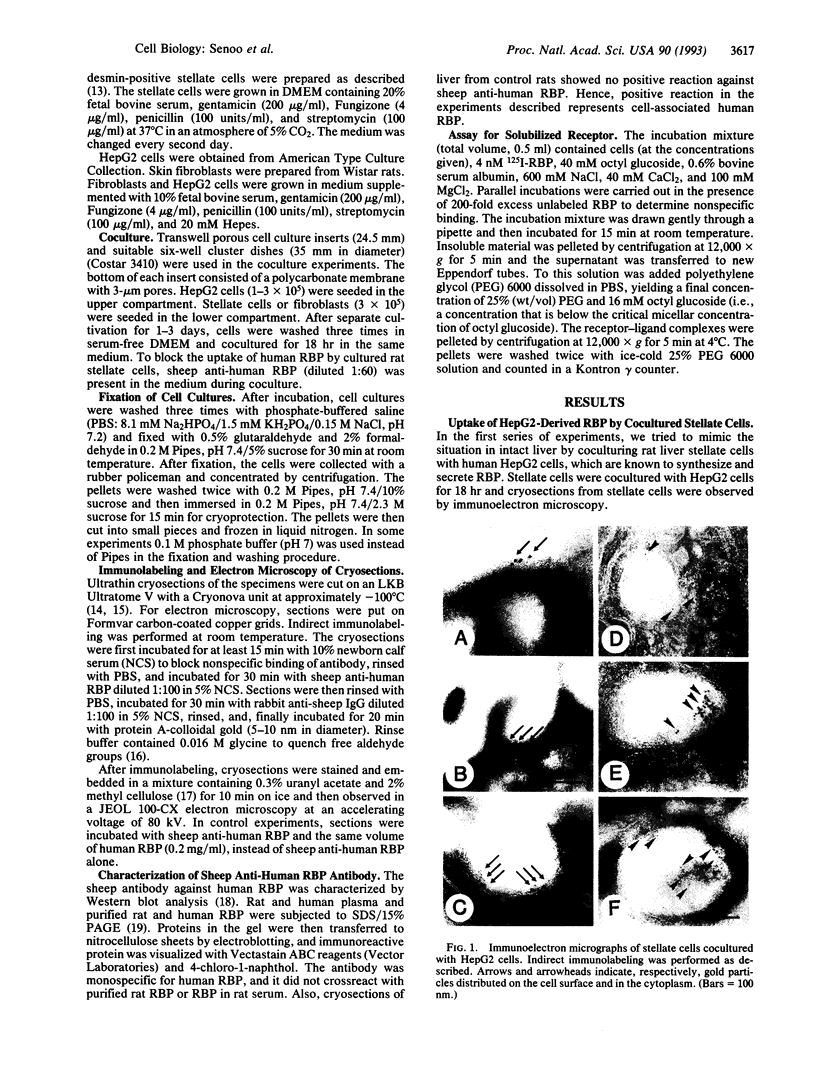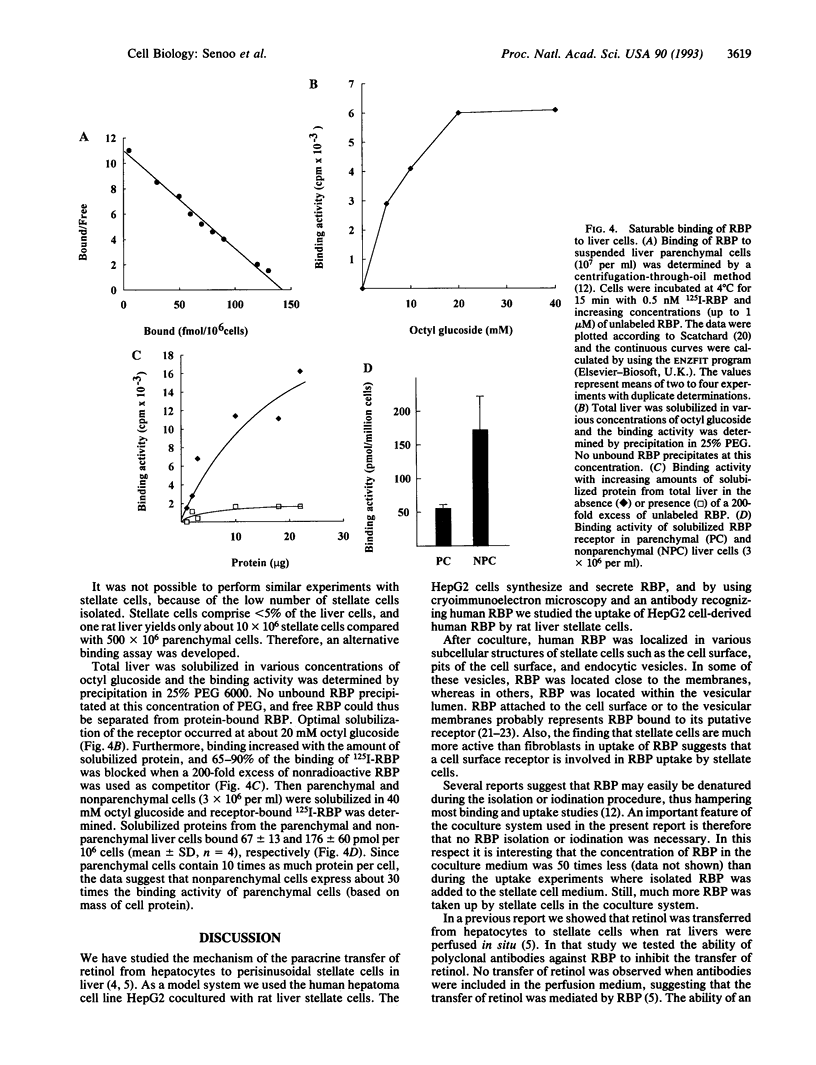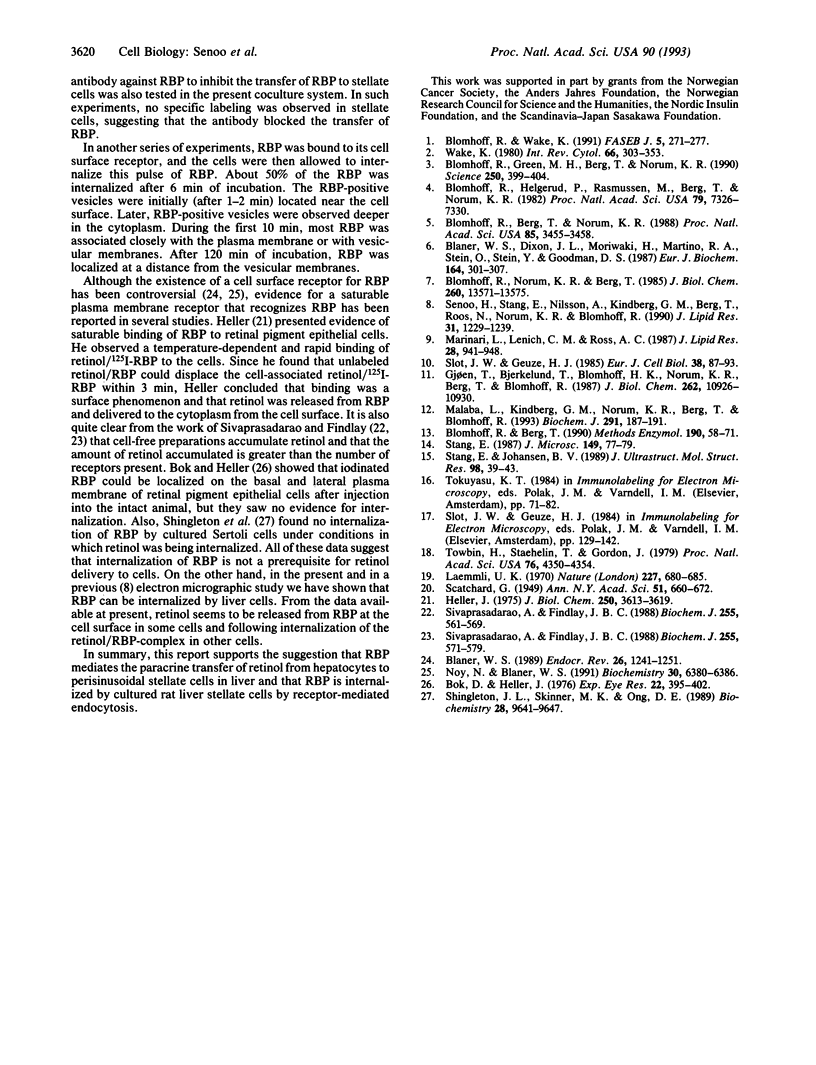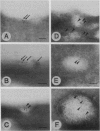Abstract
Rat liver stellate cells were cocultured with HepG2 human hepatoma cells, which are known to synthesize and secrete retinol-binding protein (RBP). Transfer of human RBP from HepG2 cells to stellate cells was studied by cryoimmunoelectron microscopy. In stellate cells, human RBP was found on the cell surface and within endosomes. The transfer of human RBP from HepG2 cells to stellate cells was blocked by addition of RBP antibodies to the culture medium. Very little uptake of RBP was observed when fibroblasts were cocultured with HepG2 cells. In a series of experiments, RBP was bound to its putative cell surface receptor at 4 degrees C, and the stellate cells were washed and then incubated at 37 degrees C in order to allow them to internalize a pulse of RBP. About 50% of the RBP was internalized after 6 min of incubation. The RBP-positive vesicles were initially (after 1-2 min) located close to the cell surface and later were found deeper in the cytoplasm. During the first 10 min, RBP was mainly observed in close association with membranes. After 2 hr, however, most RBP was localized in intracellular vesicles at a distance from the vesicular membranes, suggesting that RBP had been released from its receptor. Saturable binding of RBP to liver cells was demonstrated when cells were incubated with 125I-RBP at 4 degrees C and cell-associated radioactivity was determined. The calculated dissociation constant for the specific binding was 12.7 +/- 3.2 nM. A binding assay was also developed for determination of solubilized RBP receptor. Solubilized proteins from the nonparenchymal liver cells bound about 30 times more 125I-labeled RBP than did parenchymal cells (based on mass of cell protein). These data suggest that RBP mediates the paracrine transfer of retinol from hepatocytes to perisinusoidal stellate cells in liver and that stellate cells bind and internalize RBP by receptor-mediated endocytosis.
Full text
PDF




Images in this article
Selected References
These references are in PubMed. This may not be the complete list of references from this article.
- Blaner W. S., Dixon J. L., Moriwaki H., Martino R. A., Stein O., Stein Y., Goodman D. S. Studies on the in vivo transfer of retinoids from parenchymal to stellate cells in rat liver. Eur J Biochem. 1987 Apr 15;164(2):301–307. doi: 10.1111/j.1432-1033.1987.tb11058.x. [DOI] [PubMed] [Google Scholar]
- Blaner W. S., Hendriks H. F., Brouwer A., de Leeuw A. M., Knook D. L., Goodman D. S. Retinoids, retinoid-binding proteins, and retinyl palmitate hydrolase distributions in different types of rat liver cells. J Lipid Res. 1985 Oct;26(10):1241–1251. [PubMed] [Google Scholar]
- Blomhoff R., Berg T. Isolation and cultivation of rat liver stellate cells. Methods Enzymol. 1990;190:58–71. doi: 10.1016/0076-6879(90)90009-p. [DOI] [PubMed] [Google Scholar]
- Blomhoff R., Berg T., Norum K. R. Transfer of retinol from parenchymal to stellate cells in liver is mediated by retinol-binding protein. Proc Natl Acad Sci U S A. 1988 May;85(10):3455–3458. doi: 10.1073/pnas.85.10.3455. [DOI] [PMC free article] [PubMed] [Google Scholar]
- Blomhoff R., Green M. H., Berg T., Norum K. R. Transport and storage of vitamin A. Science. 1990 Oct 19;250(4979):399–404. doi: 10.1126/science.2218545. [DOI] [PubMed] [Google Scholar]
- Blomhoff R., Helgerud P., Rasmussen M., Berg T., Norum K. R. In vivo uptake of chylomicron [3H]retinyl ester by rat liver: evidence for retinol transfer from parenchymal to nonparenchymal cells. Proc Natl Acad Sci U S A. 1982 Dec;79(23):7326–7330. doi: 10.1073/pnas.79.23.7326. [DOI] [PMC free article] [PubMed] [Google Scholar]
- Blomhoff R., Norum K. R., Berg T. Hepatic uptake of [3H]retinol bound to the serum retinol binding protein involves both parenchymal and perisinusoidal stellate cells. J Biol Chem. 1985 Nov 5;260(25):13571–13575. [PubMed] [Google Scholar]
- Blomhoff R., Wake K. Perisinusoidal stellate cells of the liver: important roles in retinol metabolism and fibrosis. FASEB J. 1991 Mar 1;5(3):271–277. doi: 10.1096/fasebj.5.3.2001786. [DOI] [PubMed] [Google Scholar]
- Bok D., Heller J. Transport of retinol from the blood to the retina: an autoradiographic study of the pigment epithelial cell surface receptor for plasma retinol-binding protein. Exp Eye Res. 1976 May;22(5):395–402. doi: 10.1016/0014-4835(76)90177-9. [DOI] [PubMed] [Google Scholar]
- Gjøen T., Bjerkelund T., Blomhoff H. K., Norum K. R., Berg T., Blomhoff R. Liver takes up retinol-binding protein from plasma. J Biol Chem. 1987 Aug 15;262(23):10926–10930. [PubMed] [Google Scholar]
- Heller J. Interactions of plasma retinol-binding protein with its receptor. Specific binding of bovine and human retinol-binding protein to pigment epithelium cells from bovine eyes. J Biol Chem. 1975 May 25;250(10):3613–3619. [PubMed] [Google Scholar]
- Laemmli U. K. Cleavage of structural proteins during the assembly of the head of bacteriophage T4. Nature. 1970 Aug 15;227(5259):680–685. doi: 10.1038/227680a0. [DOI] [PubMed] [Google Scholar]
- Malaba L., Kindberg G. M., Norum K. R., Berg T., Blomhoff R. Receptor-mediated endocytosis of retinol-binding protein by liver parenchymal cells: interference by radioactive iodination. Biochem J. 1993 Apr 1;291(Pt 1):187–191. doi: 10.1042/bj2910187. [DOI] [PMC free article] [PubMed] [Google Scholar]
- Marinari L., Lenich C. M., Ross A. C. Production and secretion of retinol-binding protein by a human hepatoma cell line, HepG2. J Lipid Res. 1987 Aug;28(8):941–948. [PubMed] [Google Scholar]
- Noy N., Blaner W. S. Interactions of retinol with binding proteins: studies with rat cellular retinol-binding protein and with rat retinol-binding protein. Biochemistry. 1991 Jul 2;30(26):6380–6386. doi: 10.1021/bi00240a005. [DOI] [PubMed] [Google Scholar]
- Senoo H., Stang E., Nilsson A., Kindberg G. M., Berg T., Roos N., Norum K. R., Blomhoff R. Internalization of retinol-binding protein in parenchymal and stellate cells of rat liver. J Lipid Res. 1990 Jul;31(7):1229–1239. [PubMed] [Google Scholar]
- Shingleton J. L., Skinner M. K., Ong D. E. Characteristics of retinol accumulation from serum retinol-binding protein by cultured Sertoli cells. Biochemistry. 1989 Dec 12;28(25):9641–9647. doi: 10.1021/bi00451a015. [DOI] [PubMed] [Google Scholar]
- Sivaprasadarao A., Findlay J. B. The interaction of retinol-binding protein with its plasma-membrane receptor. Biochem J. 1988 Oct 15;255(2):561–569. [PMC free article] [PubMed] [Google Scholar]
- Sivaprasadarao A., Findlay J. B. The mechanism of uptake of retinol by plasma-membrane vesicles. Biochem J. 1988 Oct 15;255(2):571–579. [PMC free article] [PubMed] [Google Scholar]
- Slot J. W., Geuze H. J. A new method of preparing gold probes for multiple-labeling cytochemistry. Eur J Cell Biol. 1985 Jul;38(1):87–93. [PubMed] [Google Scholar]
- Towbin H., Staehelin T., Gordon J. Electrophoretic transfer of proteins from polyacrylamide gels to nitrocellulose sheets: procedure and some applications. Proc Natl Acad Sci U S A. 1979 Sep;76(9):4350–4354. doi: 10.1073/pnas.76.9.4350. [DOI] [PMC free article] [PubMed] [Google Scholar]
- Wake K. Perisinusoidal stellate cells (fat-storing cells, interstitial cells, lipocytes), their related structure in and around the liver sinusoids, and vitamin A-storing cells in extrahepatic organs. Int Rev Cytol. 1980;66:303–353. doi: 10.1016/s0074-7696(08)61977-4. [DOI] [PubMed] [Google Scholar]




